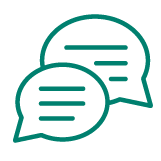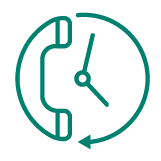- Review your account activity regularly, watching for unfamiliar transactions
- Be aware of phishing scams and avoid clicking on unfamiliar links. See below for description of phishing
- If you're contacted by someone claiming to be from Sunshine Coast Credit Union or another business, asking for your personal or banking details, always verify their identity. Call them back on the phone number listed on their company website
- Visit Canada Revenue Agency for more fraud prevention details
How to recognize, prevent and stop fraud
Protecting and safeguarding member information is our highest priority.
Common tips for fraud identification and prevention
Types of fraud - what to look for
Identity theft
Identity theft occurs when your personal details are stolen and then used for financial gain or other criminal activity - potentially resulting in debt, poor credit ratings or other legal ramifications. Ways to tell if your identity has been stolen are:
- You see withdrawals from your bank account that you can’t explain
- You don’t get your bills or other mail
- Merchants refuse your checks
- Debt collectors call you about debts that aren’t yours
- You find unfamiliar accounts or charges on your credit report
- Medical providers bill you for services you didn’t use
- Your health plan rejects your legitimate medical claim because the records show you’ve reached your benefits limit
- A health plan won’t cover you because your medical records show a condition you don’t have
- The CRA notifies you that more than one tax return was filed in your name, or that you have income from an employer you don’t work for
- You get a notice that your information was compromised by a data breach at a company where you do business or have an account
Document theft
When a criminal accesses your private information through unlocked mailboxes or discarded personal documents such as utility bills, insurance renewals or health records/receipts. The only reliable way to tell if you have suffered document theft is the trail of negative results it creates for you, virtually identical to that of identity theft.
Phishing
Phishing occurs when internet scammers use deception to obtain your personal information via email or phone. Phishing works by sending communications, which appear to be from your financial institution, but they are not. You are asked, supposedly by your financial institution, to log in to your online banking to verify account information. Often some type of security concern is cited as the issue.
The fake email instructs you to click on a link that takes you to a non-legitimate version of your online banking site – one that is largely indistinguishable from the legitimate site – and you’ll be asked to enter your credentials.
Phishing emails may include:
- Warnings about account closures
- Requests to update your information
- Offers to register for a new service
- Offers for pre-approved credit cards
- Free virus-protection programs
Once you click on the link, which directs you to a phishing website, you’ll be prompted to enter personal or banking information. Phishing scams seek personal details, such as your address, social security number or mother’s maiden name. The details obtained will then be used for identity theft and transferring funds from your account.
Scam emails purporting to be from your credit card company or financial institution often have some telling signs, including:
- Poor spelling or grammar
- Alarmist content, warning that your account will be closed if you don’t provide your banking or personal details immediately
- Notices that you’ve won a prize and are required to pay a fee in order to claim it
Never provide personal details or any account details in an email. Regular emails are not a secure form of communication. If you receive a message that you are unsure about, please contact us
Hackers
There are a great number of hackers out there, using an even greater array of malware to compromise networks, computers and communities. Having a watchful eye and updating your security regularly is critical. If any of the following occur, you likely have received a hacking attempt or suffered an actual hack:
- You get a ransomware message
- You get a fake antivirus message
- You have unwanted browser toolbars
- Your internet searches are redirected
- You see frequent, random popups
- Your friends receive social media invitations from you that you didn’t send
- Your online password isn’t working
- You observe unexpected software installs
- Your mouse moves between programs and makes selections
- Antimalware, Task Manager or Registry Editor is disabled
- Your online account is missing money
- You’ve been notified by someone you’ve been hacked
- Confidential data has been leaked
- Your credentials are in a password dump
- You observe strange network traffic patterns
Card fraud
Card fraud occurs when a criminal:
- ‘Skims’ or copies the information stored on your card’s magnetic strip to access your funds
- Steals your card or uses your lost one to make unauthorized purchases or withdraw cash
- Intercepts your card during mail delivery
To identify if you have experienced card fraud:
- Watch for new unexplained bills
- Keep on the lookout for refusal of credit
- Stay alert on calls from your bank or credit card carrier
Cheque fraud
Cheque fraud occurs when a criminal:
- Changes a cheque’s amount or payee details without authorization
- Steals a cheque and alters it
- Produces copies of a cheque
- Uses counterfeit invoices to receive cheques
- Deposits a cheque into someone else’s account without authorization
- Pays by cheque with knowledge of insufficient funds in the account
To identify if you have experienced cheque fraud:
- Stay aware of withdrawals from your account
- Keep a list of every cheque you have written each month to cross check with your account statement on a monthly basis to ensure it matches up
- Have a unique signature that you can also identify as your own
How to protect yourself from fraud
View some tips
- The letter “s” in ‘https’ indicates you are navigating in a secure site, in comparison to the open and unprotected ‘http’ URLs. Look for the ‘https’ when online shopping, too
- Check your credit report every year and report problems immediately
- Be wary of conducting financial transactions using a public WiFi hotspot
- Be cautious about how much personal information you share via social network sites
How to report fraud
If you are concerned that you have seen fraudulent or even questionable charges or communications related to your finances, accounts or credit cards, take action immediately.
Identity theft and fraud prevention
Book a Financial Literacy session for your organization or workplace.
Register for free Mobile Security Alerts
Mobile Alerts give you extra peace of mind by instantly alerting you to potentially fraudulent activity in your online banking. You’ll be immediately notified if someone logs into your account, changes your PAC, or your account is locked out by too many access attempts.
Know your responsibilities and see how we protect your information by visiting Online Security.
Resources to help identify fraud
The Competition Bureau Canada has recently released its 2nd edition of “The Little Black Book of Scams”. This pamphlet outlines the most popular scams and fraud schemes currently in practice as well as ways to spot them and methods of safeguarding yourself.
Download the Little Black Book of Scams 2








